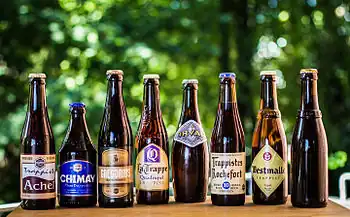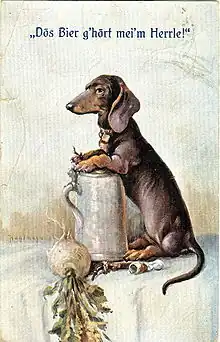Beer
alcoholic drink
Beer is possibly the most commonly drunk alcoholic beverage in the world, and has a history spanning back to the very oldest agricultural civilizations. The definition of what "beer" is varies by region and culture: the famous Bavarian law of 1516 that said beer could only contain water, hops, and barley (yeast occurred naturally in the air). The greater beer family, however, includes fermented drinks made from barley, wheat, rye, maize, sorghum, rice, and many others, fermented with different varieties of yeasts and bacteria, and flavored with all kinds of additions such as herbs (notably hops), fruits, spices, and even smoke.
- This article is about the beverage. See also Beer (disambiguation).
Understand
| “ | Here's the beautiful lady with the beer. | ” |
—Ernest Hemingway, The Sun Also Rises | ||
History
There is a theory that beer is even older than farming, since it's known that collecting wild grains preceded domestication, and it's possible brewing was one of the ways of processing that wild harvest. Some even think it was the need for more grain to make beer that motivated early experiments in cultivation. In any case, wherever you find grain agriculture, you will find beer-like drinks around the world, such as choujiu, a Chinese rice beverage or chicha, an Andean maize drink.
Beer as understood in European culture is mainly based on barley, but wheat, rye, oats and other grain are possible and in Russia and Ukraine toasted bread crust is fermented to make kvas. These days beer is mostly fermented only with pure strains of domesticated yeast, but wild yeasts and bacteria can also be involved. The main flavouring addition to modern European beers is hops flowers, but cultivation of this plant only really began in Germany by the 11th century and England not until the 16th; before that a mixture of other herbs was used under the general name of "gruit". Gruited beers are now a rarity compared to hopped ones.
Expansion around the world
The spread of beer around the world has been determined largely by three things: the climate required for growing barley and hops, legal policy towards alcohol in various countries, and European colonialism.
The range of hops overlaps somewhat with that of wine grapes, but grapes tend to prefer warmer, drier climates, leading to a distinct "belt" effect across Europe: wine is the most popular drink in the southern, Mediterranean climates, beer in the temperate middle, and spirits (whisky, vodka) in the colder north.
Beer was also favoured by governments throughout recent centuries over spirits for being less socially disruptive. For example during the "gin craze" in Britain in the first half of the 18th century, beer was promoted as a more wholesome alternative and likewise with the British campaign against potín (moonshine) in Ireland. In Poland, there is even a "beer-drinkers' political party", that wants to move that country culturally away from vodka.
The most-far reaching factor on the spread of beer was the movement of European peoples to new countries during the age of colonialism. This is how European-style beer came to replace indigenous fermented drinks as the main beverage of choice for many cultures around the world. The three countries with the largest total consumption of beer are all outside Europe: namely, China, the United States of America, and Brazil. However, the per capita rate remains highest in countries in Central Europe as well as in Namibia, a country with a German colonial history.
Destinations
Austria
- See also: Vienna microbreweries
Like its neighbours in Central Europe, Austria is noted for its beer scene, particularly in the capital of Vienna.
Belgium

Belgium is the beer nerd's mecca, being home to many small, ancient breweries run by Catholic monks, notably the Trappists. Beer isn't a fad here, it's a way of life. A traveller doesn't need to go out to each tiny brewery to sample the beers here: expect to find things considered exotic elsewhere like kriek (lacto-fermented beer flavoured with cherry) on tap at the local cafe and a variety of Trappist brews in bottles at the local corner store. However, if you do want to see where the magic happens, try:
- Grimbergen, Flemish Brabant, home of the Abbey Beer Museum.
- Hoegaarden, Flemish Brabant, home to the world's most famous wheat beer
- Leuven, Flemish Brabant, home of InBev, the world's largest brewing company, and its flagship beer, Stella Artois.
- Poperinge, West Flanders, home of the Beer and Hops Museum and a hops parade and festival in September one every three years.
Canada
- See also: Beer in Ontario
The Canadian beer scene has exploded, going from a few dozen breweries in the 1990s to 380 in 2013 to 995 in 2018. The most established hub is undoubtedly Montreal, home of the massive Mondial de la bière festival over four days in May. The other well-established scene is in British Columbia, particularly its capital, home of Canada's first brewpub, Spinnakers. The Kitchener–Waterloo Oktoberfest in Ontario is an annual three-week festival It is the second-largest Oktoberfest in the world. Every province and territory has at least one brewery. Even tiny Prince Edward Island had nine in 2018, and remote Nunavut has one that opened in 2018.
Czechia
In Czechia (aka the Czech Republic) beer is the staple drink and they have the world's highest per capita consumption. Most of that is in the form of mass-produced pale lagers, but that is understandable as the style was invented here when brewers from Bavaria adapted their style of brewing to local ingredients and tastes in Plzen (German: Pilsen) in the year 1842; hence, the style is often called a "pilsner". Likewise České Budějovice (German: Budweis) is the home of Budweiser. No, not that one, the original. Of course, it's possible to try things other than just pale lagers, though the selection is less varied than you would expect in such a beer-loving nation. Compensating for that is that prices are dramatically lower than in, say, Britain or Norway, so you get more brew for your buck. A "Czech style" pilsner will often have a slightly "buttery" flavor which is due to diacetyl, a chemical substance often deemed "undesired" in other beer styles.
Finland
- See also: Beer in Finland
About 80 breweries produce beer in Finland. In Finland, beer is consumed to the same extent as on average in Europe. A light lager is by far the best-selling beer in Finland. In 2016, a total of 421 million liters of beer were sold in Finland, which is 76.6 liters per person. The best-selling Finnish beer manufacturers include Hartwall, Olvi and Sinebrychoff.
Germany

- See also: German beer and wine
- Bitburg is the home of the annual Europäisches Folklore-Festival Bitburg (ethnic song and dance from around Europe accompanied by lots of beer) and its sponsor, Bitburger Brewery
- Kulmbach is home to the Museen im Kulmbacher Mönchshof: Bayerisches Brauereimuseum / Bayerisches Bäckereimuseum / Deutsches Gewürzmuseum (The Bavarian Brewery and Bread Museum and German Spice Museum)
- Munich, home of Oktoberfest.
- Breweries in Franconia: the impressive density of breweries, beer museums, and beer gardens in Franconia requires a separate guide
Ireland
The Irish are famous for their "stout": ale made with darkly roasted malt barley, quite different from the pale lagers that dominate much of the globe (though those have made inroads in Ireland as well). Besides the famous Guinness, similar stouts are Murphy's and Beamish. Beyond that, and the occasional Irish red "cream ale" (contains no dairy!), however, there usually is not a wide variety of styles to be found on tap in Irish pubs. Beer-related tourism in Ireland isn't primarily about tasting dozens of different local specially brews, as it would be in other beer-belt countries. Instead, the focus is more on the atmosphere of the pub: its decor, its patrons and staff. The Irish often make a big deal about how much better Guinness supposedly tastes in some place compared to others, but one suspects this is mostly "blarney" (exaggerated story telling). And it's really blarney, more than beer, that you should go to an Irish pub to experience.
If you feel the need to spend time in the world of brewing, try the Guinness Experience at the old St James's Gate in Dublin. You don't see a working brewery, but get to see a museum-style exhibit of brewing and beer history in Ireland, plus a pint at the top of the building with a stunning view of the city.
Netherlands
The market is dominated by mass-market lagers (Amstel, Grolsch and Heineken) so you'll have to hunt to find more interesting brews. You could go to the Heineken Experience in Amsterdam, if that's your thing. More likely you'll want to visit two of the world's ten Trappist breweries here, or enjoy a witbier (white beer) or bok when available.
United Kingdom
The Campaign for Real Ales (CamRA) has a listing at whatpub.com of 35,000 pubs in the U.K., indicating which ones serve "real ales" (those without added CO2, usually hand-pumped from a cask). This is enough to keep most beer tourists busy for a lifetime. The largest beer festival in the country is the Great British Beer Festival, held each year in August in London.
United States
.svg.png.webp)
Microbrewing is a growing industry in the United States, but it is very regionally divergent. The regions with the greatest concentrations of breweries are the Pacific Northwest (particularly Portland and the Willamette Valley), the Mountain States, and New England. Not coincidentally, these are generally places that hops and barley can grow, but wine grapes generally do not (with exceptions). The cities of Milwaukee and St. Louis are noted for their industrial brewing heritage, which has also spawned a craft brewing scene in those cities and to lesser extent in the Midwest more generally. The only regions seemingly immune to the craft craze are the Great Plains and the South, but even there one can find craft brews if one knows where to look. The largest beer festival in the United States is the Great American Beer Festival, held each year in September in Denver.
Itineraries
- Fünf Seidla Steig, a hiking trail that gives access to Breweries in Franconia
- Craft brewery tour of Southwest Wisconsin
- Vienna microbreweries
Do
| “ | O'zapft is! | ” |
—Oktoberfest is traditionally opened by the Mayor of Munich opening the first barrel of beer and exclaiming "It's tapped!" | ||
- Oktoberfest, Munich/Ludwigsvorstadt-Isarvorstadt. The beer festival, taking place each September (leading up to October) in Munich with more than 6 million visitors. (updated Jan 2019)
- Mondial de la bière (Montreal Beer Festival). (updated Sep 2019)